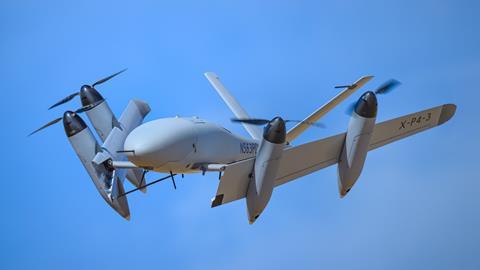The US Navy (USN) has been in discussions with Sierra Nevada about adding the company to the service’s Blue Water Maritime Logistics Unmanned Aerial System (UAS) programme.
Bill Macchione, Naval Air Warfare Center Aircraft Division portfolio lead for special-purpose UAS, told FlightGlobal on 8 April that there are no restrictions on how many companies can participate in the effort.
The only requirement is willingness to invest in making UAS capable of performing in the complicated maritime environment in which USN Military Sealift Command (MSC) ships operate. That means such aircraft must be able to operate in contested environments and from ships in rough seas, for instance.

Macchione says Sierra Nevada has committed to developing technology to provide maritime logistics capability to the USN. The company would likely provide either the Voly-50 or Voly-T UAS, which it acquired by purchasing developer Volansi in late 2022.
Sierra Nevada declines to comment.
The Blue Water Maritime Logistics UAS programme seeks to solve the USN’s challenge of economically delivering light cargo – generally parts and supplies weighing up to 23kg (50lb) – over distances of at least 200-400nm (370-740km).
John Bruening, director of the MSC’s Taluga Group, which seeks to identify innovating logistics improvements, says 90% of parts transferred between ships weigh less than 23kg. But the USN typically uses large aircraft, such as Sikorsky SH-60 helicopters that cost around $5,000 per flight hour, to deliver such parts.
In addition to the expense, helicopter operations are limited by crew-rest and weather requirements, and typically must operate during daylight – restrictions that do not apply to UAS.
“In 20 minutes, I push the (UAS) out to the flight deck, I fire it up and off (it) goes,” even in the middle of the night, says Bruening. “It gives the warfare commander flexibility.”
Two companies are currently participating in the Blue Water Maritime Logistics UAS programme: Skyways (with its V2.6 UAS) and PteroDynamics (with the Transwing X-P4).
Charles Acknin, Skyways chief executive and co-founder, says his company has been experimenting with a temperature-control payload that would allow Skyways to transport cargo, such as blood, at 3-6°C (37-43°F).
The company’s new aircraft, the V3, has been undergoing flight testing since 2023 and has been demonstrated, in flight, to customers. The UAS has a maximum useful payload of 45kg and a maximum range exceeding 869nm.
PteroDynamics said on 18 April that it participated in the US Naval Forces Southern Command/US 4th Fleet Hybrid Fleet Campaign event in October.
During those demonstrations, PteroDynamics’ Transwing X-P4 flew nine autonomous launch-and-recovery flights from the USNS Burlington, an expeditionary fast transport ship.
The flights demonstrated integration of the X-P4 with ship operations, and its ability to autonomously take-off and land from a flight deck with computer vision. The aircraft also demonstrated transitioning from vertical to forward flight, and navigation to and from a moving ship.
The Blue Water Maritime Logistics UAS companies are to participate in the prestigious biennial Rim of the Pacific, a multi-national maritime exercise.
Story corrected on 23 April to note that two companies, not four, are participating in the Blue Water programme. The other two firms previously mentioned, Shield AI (with its V-Bat tail-sitter) and L3Harris (with its FVR-90) are performing ship-to-shore resupply missions under a USN medical contract with the Defense Innovation Unit, says the USN’s Naval Medical Research Command.


























